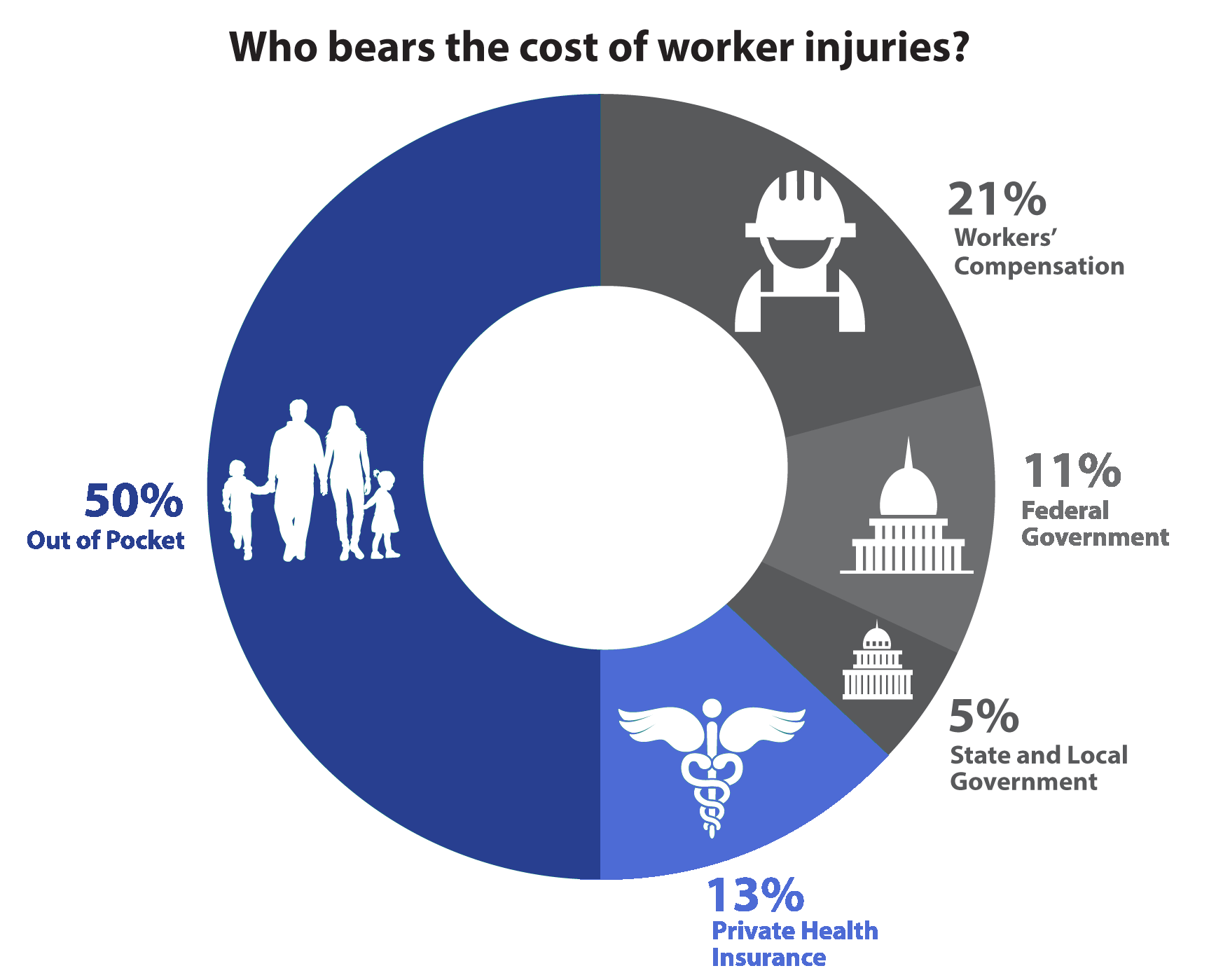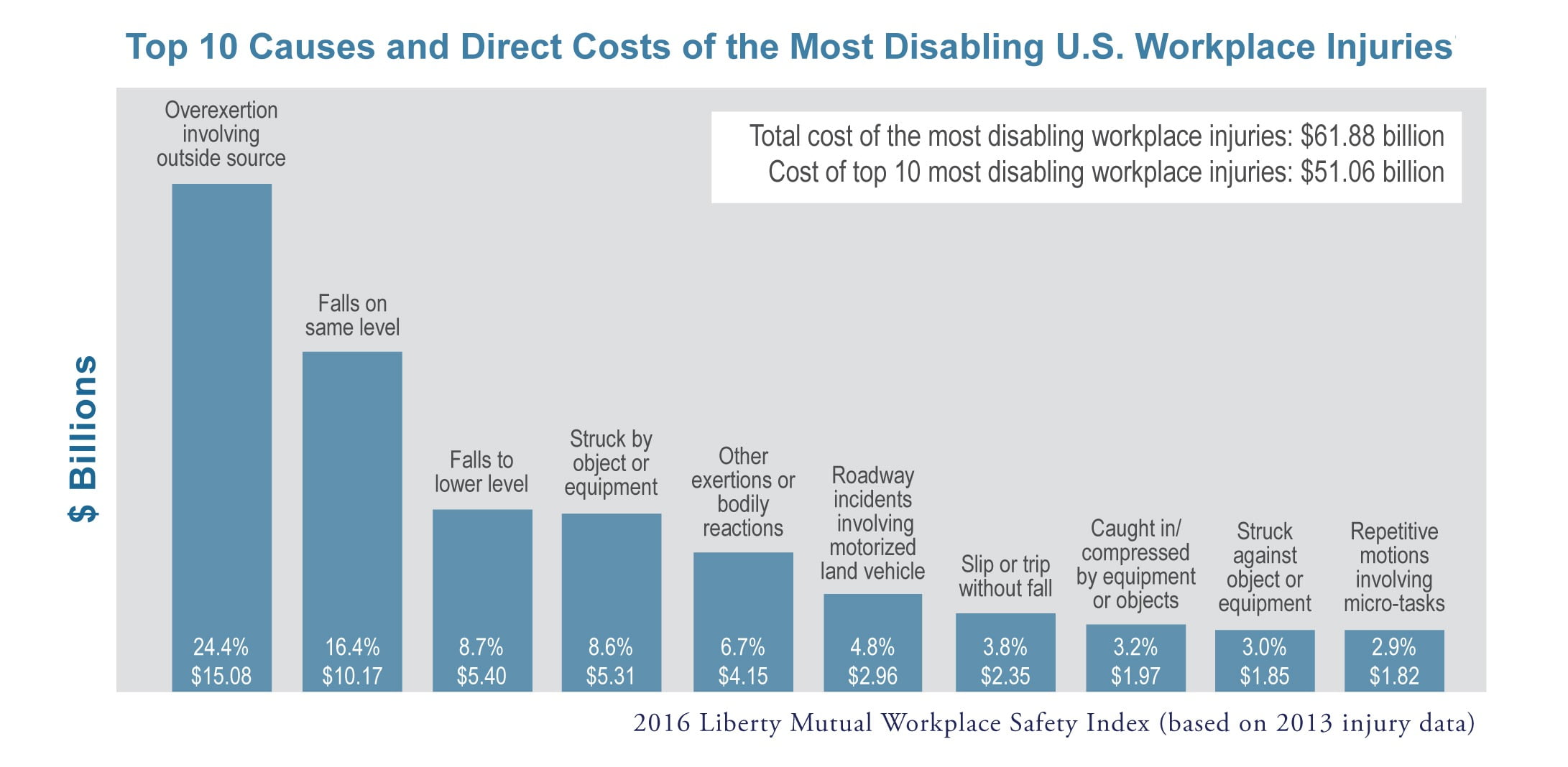As we examine the costs of work-related injuries, we gain insight into the perspectives around this issue, along with a better understanding of the myriad of factors that impact those costs. Some of the costs are harder to document, such as the effect on co-worker morale, or a reduction in productivity throughout due to a work-related injury. While the hard costs that are easier to quantify are large enough, we all take notice and look to best practices to minimize their negative influence on the employer’s bottom line and the employee’s well being.
How Much Work-Related Injuries Cost
Every year, workplace injuries cost US businesses $61.88 billion in workers’ compensation claims. That’s roughly $1.19 billion every week. It certainly is costly for businesses nationwide, but that cost can also vary depending on how quickly an injury is reported.
The median cost for workplace injuries are lowest for injuries reported within the first two weeks, averaging about $13,120 per claim. But delayed injury reporting can increase workers’ compensation costs as much as 51%. After two weeks, the longer an employee waits to file a claim, the more costly it is likely to be.
However, many times the true severity of an injury may not be immediately obvious. Many injured workers think the pain will go away on its own, and when it’s still there days or weeks later, that’s when they decide to take action. Unfortunately, many businesses have rules that punish workers for reporting claims late. While it is true that waiting too long will ultimately cost more, these strict rules actually discourage employees from reporting a claim at all. They may hide their injuries, causing the untreated condition to worsen.
Beyond the $61.88 billion that workers’ compensation costs businesses each year, it has recently been reported that “employer-provided workers’ compensation insurance benefits cover only 21% of the actual costs of a workplace injury or illness, including lost wages, medical expenses, and rehabilitation.” OSHA’s report, “Adding Inequality to Injury: The Costs of Failing to Protect Workers on the Job,” included the following graph:
Moreover, many workers don’t receive any workers’ compensation benefits it all. Approximately 3 million workers are injured each year who seek workers’ compensation, however this is only a fraction of the total number of people who are actually injured. It’s estimated that fewer than 40% of eligible workers apply for benefits, leaving the other 60% of injured workers footing the bills themselves.
Main Causes of Injury
According to the 2016 Liberty Mutual Workplace Safety Index, the top 10 causes of workplace injury account for $51.06 billion (82.5%) of all workers’ compensation costs. The following causes are the most common; each cause includes the overall percentage of injuries and the total annual cost.
- Overexertion involving outside source (including injuries related to lifting, pushing, pulling, holding, carrying, or throwing objects): 24.4%, $15.08 billion
- Falls on same level: 16.4%, $10.17 billion
- Falls to lower level: 8.7%, $5.40 billion
- Struck by object or equipment: 8.6%, $5.31 billion
- Other exertions or bodily reactions: 6.7%, $4.15 billion
- Roadway incidents involving motorized land vehicle: 4.8%, $2.96 billion
- Slip or trip without fall: 3.8%, $2.35 billion
- Caught in or compressed by equipment or objects: 3.2%, $1.97 billion
- Struck against object or equipment, 3.0%, $1.85 billion, and
- Repetitive motions involving micro-tasks: 2.9%, $1.82 billion.
How to Cut Costs and Reduce OSHA Claims
Work-related injuries are clearly a huge cost in the United States, not just for businesses, but also for the workers themselves. How can we cut those costs and reduce OSHA claims? There are a few key tactics you can use:
1. Make the workplace safer and more comfortable
The first step is also the most obvious, and one that is an OSHA requirement. Make your workplace as safe as possible. Do everything you can to eliminate potential dangers, and invest in making your business worksites safe and clean. Doing so will save you money in workers’ compensation claims, and will also save your employees unneeded suffering and pain.
Don’t just stop at ensuring your workplace is safe: Make sure it is also comfortable. Do an ergonomics assessment to make sure the workspace will not cause undue stress and lead to aches and pains. Muscular pain at work can end up costing a lot, and it is best to minimize the discomfort your employees feel.
2. Provide onsite therapy to prevent injuries and claims
Onsite muscular treatment therapy can provide immediate results, not only by preventing an injury from occurring in the first place, but also by intervening before an existing strain develops into an OSHA-recordable injury. Onsite therapy can reduce or fully eliminate muscular pain and the associated workers’ comp and healthcare claims. Best practices, like onsite treatment therapy, strengthen the wellness programs in your business, helping to keep employees healthy and happy.
3. Don’t punish employees who report a claim late
Many businesses have deadlines and punishment for employees who may report a claim late. This discourages employees from reporting a claim, and can make a fairly simple injury much more costly down the road. Do encourage employees to report injuries as soon as they can, but don’t put up extra roadblocks for those that may not realize how bad an injury is until it’s too late. Deadlines won’t do your company any good here.
In Conclusion
Striving for a proactive environment and creating a culture of health in your workplace will help you achieve lower rates of incidence and reduce your overall costs associated with work-related injuries. Working continuously toward these common goals will positively impact your employees, productivity, and your bottom line.




